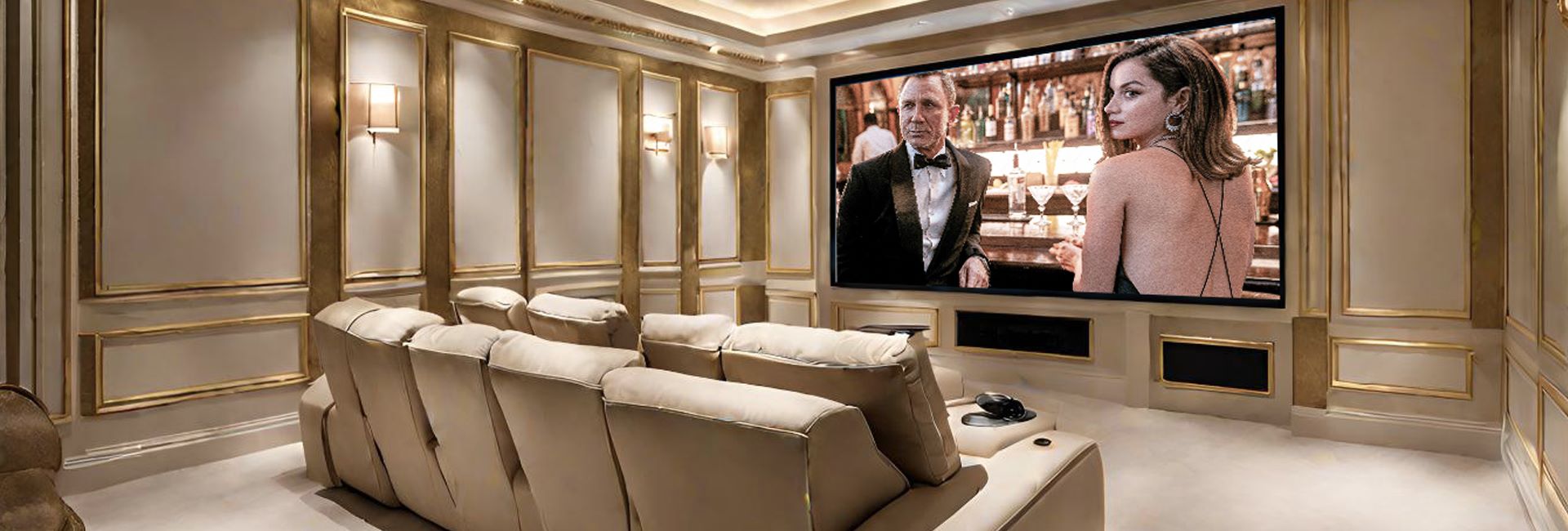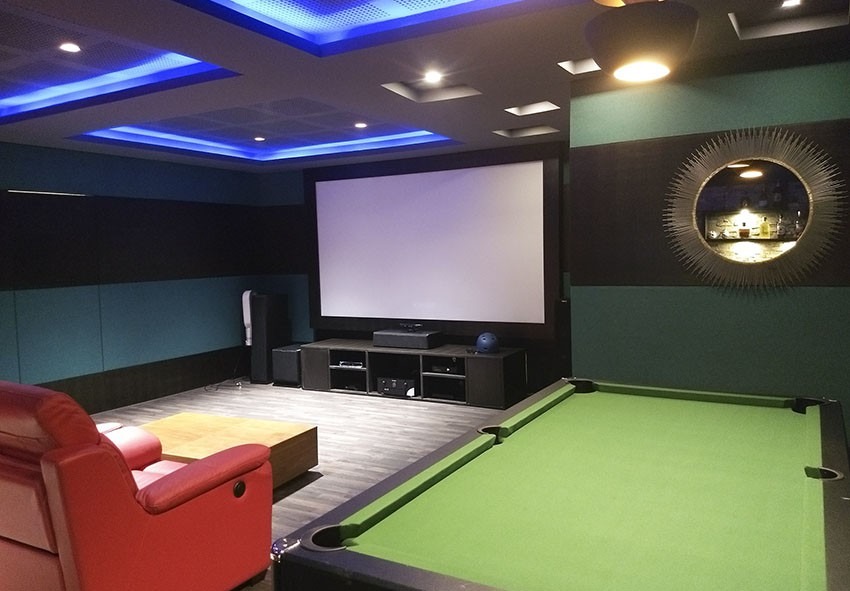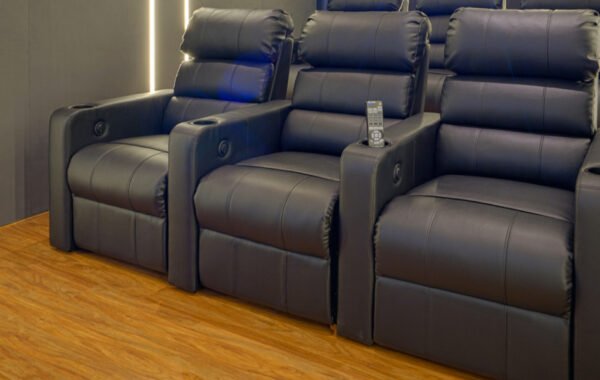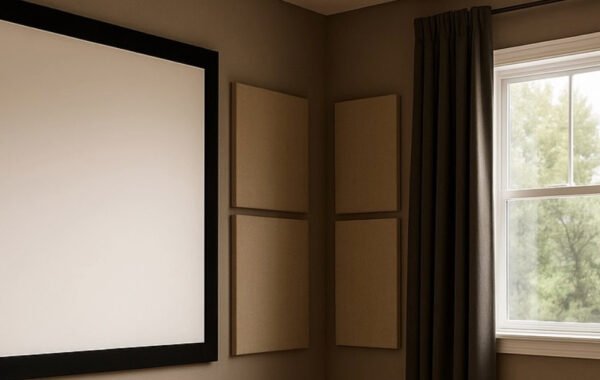
How to build Home Theater using the 12 Point GUIDE
Every time a crisis hits the world, we humans compromise and sacrifice on many things. This Covid-19 situation has been no less. While many lost jobs, few great businesses even hit the bedrock. Cinema halls and theatres are no exception. The conditions are so grave that it might take several more unpredictable months for them to revive. While health, hygiene, and social distancing top the priorities, you might as well consider having your home theater room. Life is indeed too short to spend our valuable time on less worthy things. Why run to the cinema theater when you can have the same fun right at your comfortable home? To top it all, you get to experience the thrill endlessly at any time and at multiple times you want.
With the right knowledge and supervision, it is always possible to build your home theater. Let us now look into certain prevailing conditions necessary for you to come up with a good home theater design.

1. Interiors/Aesthetics:
A house feels like your home when you feel connected to it. Every room’s aura influences your thoughts and personality. It, therefore, becomes significantly essential for you to choose every interior component rightly.
A home theater, though meant for a cinematic movie experience, requires considerable attention to make it efficient in serving its purpose as well as to blend it as one among your other rooms. Before getting through the equipment, Home theater acoustical panels, and other such essentials, you might want to decide on the Home theater interior design scheme under the guidance of an in-house architect or designer.
Home Theater Interior Design, being done as the primary most step holds the maximum benefit as the other room requirements can thereupon be matched with the decided aesthetics, thereby bringing the best out of your home cinema.

Like your living room or bedroom, even home theater offers a massive opportunity to invoke the artist inside you. Be it based on a theme or colour; you can be as innovative as possible.
With the sky as your limit, it’s you who can choose how uniquely beautiful your home theater design should be and even witness it turn into reality. Accordingly, audio-video systems and home theater furniture are selected such that they complement your Home theater interiors.
Though you can enjoy a free hand for your home theater interiors, there are specific criteria to be looked at! Home theater acoustics is a very crucial requirement of every home cinema and has its fulfilments.
You can expect your cinema room to deliver a brilliant performance only when it has perfect acoustical treatment in place. It is, therefore, necessary for you to come on common grounds with the Home theater interiors based on acoustics.
Another feature influencing the aesthetics of your home theater design is the placements of involved audio/video devices such as the speakers, projector etc. Each of these devices works best at certain positions to offer an extraordinary performance without any disturbance.
Based on the concluded Home theater interior design and acoustics, there are loads of secondary settlements to be done. These include selecting the right colour combination for the recliners, acoustic wall panels, home theater flooring, speaker, Video projection system, Home theater lights, paint and polishing to add an essence of life to your home theater interior design.
2.Audio System Design:
A truly High-End home theater is the one that allows you to float in the pleasure of immersive and intense audio performance. It must be immensely enjoyable that you feel yourself to be in it. This is possible by having efficient speaker placements to deliver the true impact of movies, music, and games.
Before deciding on speaker placements, you need to understand the fundamentals of a Home theater audio design.
Home theater audio speakers are of various kinds and sizes, starting from tiny satellite speakers to a fully blown THX Ultra Home cinema package. Each Home theater speaker type has a specific purpose; for instance, a full range floor standing speaker is a must if you want to feel every nuance of your soundtrack. Similarly, THX-certified speakers are always the best choice for an enthralling movie experience.

Following the required aesthetics and your preference, Home theater audio speakers can either be left visible or maintained hidden. If you opt for visible speakers, there are plenty of floorstanding and bookshelf speaker options available. In the case of invisible speakers, Klipsch THX Ultra type Home theater system serves the best with the audio systems installed behind a perforated Home theater screen.
An efficient home theater audio system has front LCR speakers, a subwoofer, rear surrounds, and ceiling atmos. The main left and right speakers go on either side of the Home theater projection screen with the center channel speaker centred below it.
Surround speakers often used in pairs around your seating area, and Atmos speakers go onto the ceiling over the seating on the same axis as that of the front left and right channel. Subwoofer, being an omnidirectional sound source can be installed at any preferred location that you think gives you the best bass quality in your Home theater room.
Often, AV processors such as those from Marantz, Anthem or Trinnov are paired with power amplifiers from Anthem & Marantz to manage all the speakers as well as to achieve a strong, enveloping Home theater sound.
3. Projection System:
Based on your budget and required excellence of performance, there are three leading Home Theater Video technologies, namely, LCD, DLP, and SXRD, each having its pros and cons. Under proper supervision, you can choose the right one from a plethora of high resolution and Ultra High definition projectors from Sony, Optoma, and Viewsonic for your Home theater Video projection.
The size of the Home theater video screen depends on your room size and seating layout. Though you might get lured into wanting a bigger screen than that required for your room, it is best to follow the norms as they intend towards providing you with efficient screen time at maximum comfort levels. Also, you have to consider the front speaker placements to enjoy an uninterrupted movie watching experience.

Depending on your preferred movie content, there are few prescribed screen ratio standards to help you choose the right sized Home theater screen. Do you crave the thrilling Dark Knight, Avengers, or other such extravagant action-packed Hollywood movies? Then 21:9 screen should be your sure shot perfect pick. For other local HDTV and regional movie playback, the 16:9 screen will serve you sufficiently.
Though projection onto a Home theater screen majorly depends upon the projector and its characters, the surrounding room environment also has considerable influence over it. If your Home theater room has a dark finish with dark walls, furniture, and ceiling, always go with a white screen having a gain rate between 1 and 1.3. White also serves the best with a high contrast projector.
On the other hand, a grey screen also referred to as a high-contrast home theater screen wok well for lighter rooms to boost the contrast of digital projectors. Grey screen also absorbs ambient light better than that of a white screen.
4. Electrical:
Suppose your home theater system is built around a passive speaker system. In that case, the AVR, projector, subwoofer along with Home theater lighting and electric recliners will require a constant power supply.
Each cable and wire circuitry has different demands. It is, therefore, necessary for you to be well aware of them all before starting with the connections. Firstly make sure that the speaker cables, projector HDMI cables, and electrical wires terminate at CTP or Cable Termination Point below the Home theater video screen. The projector requires a separate 1 KVA Sinewave Online UPS with 20 mins backup.
While organizing the cables, do not lay the power Cable and speaker cable/HDMI/RCA cable in the same conduit. Also, You must ensure separate MCB connection just for your audio-video equipment. All Home theater audio-video and electrical cables are laid directly inside the room with only the Internet and Tata Sky connectivity wires brought from outside.
Since India undergoes a lot of power fluctuations, save your Home theater electrical equipment from damage by installing an efficient power conditioner.
5. Technical Cabling Infrastructure:
The Home theater room must have high-quality OFC speaker cable of nothing less than 14AWG thickness for the passive speakers, and a high-quality HDMI for the projector. These are the most basic cables that you would want to have in place before thinking over the further steps.
Moulded Cable for the subwoofer and CAT-6 cable for Home theater automation would complete the technical cabling work of your home theater room.
For storing equipment such as Blu-ray discs, amplifier and their flexible accessibility, you can get a Home theater audio cabinet that can be customized to blend with your Home theater interiors. But make sure that they do not disturb the surrounding speakers or your direct Home theater video screen view.
6. Home theater Interior Acoustics:
A Professional home theater consultant would always serve you the best by advising on what’s good and bad for your home theater acoustics. A Home theater consultant does so by starting with on-site acoustic measurements to analyze the room’s response to different frequencies.
These acoustic measurements allow you to notice the difference before and after acoustically treating your room. Also, they let you know the extent of treatments required for different areas of your home cinema room. In case of a problem in the future stage, these analysis guide you in an instant problem-solving without deviating from the finalized Home theater interior design scheme.
If you are into building your home theater room all by yourself, know that absorption, diffusion, and bass trapping treatments are a must to achieve actual cinema-like experience. Further, make sure to reduce the effect of modal resonances associated with bass by stuffing a few Rockwool chunks in the four corners of your room. To further learn about acoustical treatment and their benefits for home theater rooms, look into Beginners Guide to Soundproofing & Acoustics.
One of the most fondly used Home theater acoustic treatment methods is the usage of diffusion panels. Other than enhancing the aesthetical beauty, these create bigger soundstage to render you the feeling of a bigger room. Diffuser panels come in different shapes and sizes based on your budget and requirement. Our post on How to improve your Studio/Home Theater Sound with Sound Diffusion will further direct you through its application.
Home theater flooring is done with either a thick acoustical carpet or the classic wood finish. Where carpet flooring absorbs the upper registers of the audio frequency spectrum, wooden flooring reflects sound in a home theater room.
Home theater false ceiling, generally filled with different acoustic treatments, can either be furnished with acoustic tiles, fabric or Gypsum.

7. Furniture layout:
Home theater furniture layout always depends on your personal choices such as the number of seaters, the type of seating, and future customizations as and when intended by you. A typical Home theater furniture seating needs more than 6′ in terms of both depth and width. On the other hand, a Home theater sofa would need less than about 4.5′ depth.

8. Lighting:
Although not an important aspect, good home theater lighting is very much necessary as it imbibes positive vibes in your room. You can go for various Home theater lighting designs and even choose their positions on any face of the room, be it ceiling or flooring or on the walls. Out of these, Ceiling and wall lighting always rule the choice.
Home theater lights mounted on the ceiling can either be in the form of spotlights, linear strip lights, or any custom-designed lighting to enhance the aesthetics. Similarly, for wall lighting, horizontal or vertical strip lighting in between the wall panel’s elements is preferred.
Sneak into our very special Home Theater project at Arakere, Bengaluru to help you get a glimpse of few lighting designs.
9. AC:
A home theater is a completely closed space emphasizing on utmost sound and video reproduction without any interruptions. You might therefore sometimes feel lack of air or suffocated when inside it. Though equally important, it is your independent call to choose an AC of your liking. However, considering future requirements, do make provisions for AC ducts after consulting a Home theater expert in terms of installation, internal lining, and soundproofing. The general Split and Cassette AC’s work well as long as they produce low self-noise.
10. Home theater Automation:
After all the Home theater acoustics and AV components are in place, the various devices must be tuned to sync with each other flawlessly. This synchronization is carried out by automating the different parameters of audio, video, and Home theater lighting equipment through pre-programmed settings.
Be it a movie, music, leisure, reading, or party, each pre-set Home theater automation configuration is such that they adjust themselves to deliver appropriate performance for every scenario. The home theater automation system, in general, will enhance your home cinema experience while saving time.
11. Add-on Interior elements:
A home theater is not just about audio-video systems and specialized treatments. It is as vital as other spaces in your house and requires the same level of attention. You can flexibly place any decorative elements such as framed photos, posters, glow in the dark sculptures, and other such external items, as long as it doesn’t disturb your movie-watching experience.
12. Calibration and optimization:
Choosing the best systems doesn’t suffice your home theater. They further need to be carefully installed and calibrated to achieve maximum output.
Let us for now consider Jamo THX Home theater speakers and look into the installation of the same. Any Home theater audio installation begins by connecting the source devices such as Blu-Ray player, Tata Sky box onto the AV receiver. Later, all the Jamo THX Certified speakers would have to be hooked onto the AV receiver using OFC Cables.
The active Jamo D600 subwoofer requires a pre-output through a moulded RCA cable through which it is connected to the AVR. The projector, apart from the power cable, will need an HDMI cable and an optional CAT6 cable for Home theater automation purposes.
After completing all the physical connectivity, you can tune your audio systems through professional Home theater calibration software like REW or a handheld Audio Analyser.
There are several other parameters to be looked at such as setting the right sound pressure levels, the audience to Speaker distances, and audio equalizations which must be of top priority along with the subwoofer placement and output optimization.
If you are a tech-savvy person, you can calibrate a high-end home theater projector using professional software from Sony & Spyder etc. to get the best possible video output.
It’s a normal human tendency to be passionate about building your things, be it as complicated as a home theater. But it is also essential to do it the right way. Enlighten yourself with major dos and don’ts while planning a Home theatre through our post Top 7 Do’s and Dont’s for your home theater room.
Hope I have helped you considerably through all of this information related to Home Theaters Designs. Since, acoustics and system optimization can sometimes be a tricky thing, if you get into a fix at any point, feel free to consult our professional home theater consultants@99861-65200 to help convert your dream into reality.







